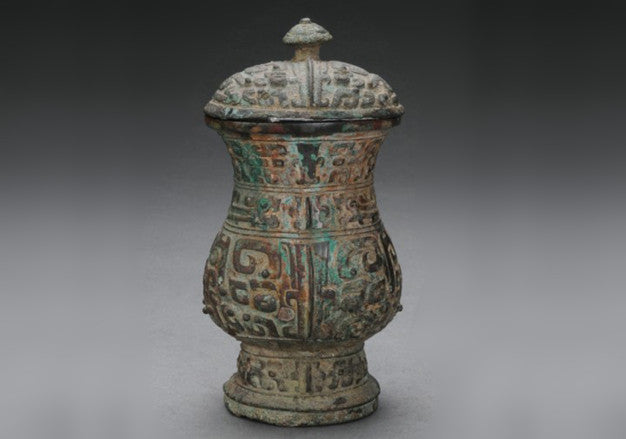
Shoufu Yi's Bronze Cup

"Shou Fu Yi" bronze zhi, bronze wine vessel, late Shang Dynasty cultural relic, the total height of the vessel is 17.5 cm, weighs 0.9 kg, unearthed in Anyang City, Henan Province.
Before liberation, tomb robbing occurred in the Xiaotun Village area of Anyang City, Henan Province, and cultural relics such as bronze zhi, gong, jade elephants, etc. were stolen. In 1966, the "Shou Fu Yi" bronze zhi and other cultural relics were found in the coal pile of the tomb robber's son's house. Subsequently, the Anyang Museum sent staff to retrieve the zhi and collected it as a collection, and then transferred it to the Henan Museum for collection.
The "Shou Fu Yi" bronze zhi is divided into two parts: the lid and the body. The lid surface is raised, oval crown-shaped, with a mushroom-shaped button on it. There are four spiral patterns on the button. The lid surface is a symmetrical animal face pattern.
The body of the vessel is oval, with a wide mouth, a narrow neck, a slightly drooping belly, a round bottom, and a high ring foot. The theme pattern is an animal face pattern. The pattern uses a thin door ridge as the nose bridge of the beast, with two horns curled outward, the body and tail spread out, and the paws extended downward. The patterns of the beast head, body and feet are symmetrically distributed. The same animal face decoration also appears below the wide mouth and abdomen of the body. Interestingly, there are two groups of curved decorations on both sides of the door ridge. The middle one seems to be the nose of the beast, as if it is breathing out, and the decoration at the bottom is like the beard on the animal's lips, which is lifelike. Because of these two decorations, the groups of animal faces on the bronze cup also look cute and lively. There are four string patterns on the neck of the body of the vessel, which separate it from the body decoration. There are four symmetrical Kuilong patterns in the middle. The dragon is upright, with an open mouth, feet, and a curled tail, separated by a door ridge in the middle. There are also four Kuilong patterns on the ring foot of the body.

Figure 1: The cover and body of the bronze zhi of "Shou Fu Yi"
The same inscription "Shou Fu Yi" can be found inside the cover and on the bottom of the zhi. There are 28 bronze vessels with the inscription "Shou" in the Shang Dynasty, and ten of them can be found at the site of excavation, six of which are from Anyang. In addition to this "Shou Fu Yi" bronze zhi, four bronze vessels with the inscriptions "Shou", "Ya Shou" and "Shou Ge" were unearthed from M1001 in the northwest of Houjiazhuang, Anyang; and a Shou Yi Jue was unearthed from M1 in the north of Wuguan Village. In 1976, one Shou Ding, one Shou Jue and one Xin Shou Hu were unearthed in Qianxiguan, Gaocheng County, Hebei Province. In 1927, warlord Dang Yukun unearthed a "Shou Fu Xin" zhi when he privately excavated an ancient tomb in Daijiawan, Baoji County, Shaanxi Province (now Chencang Township, Jintai District, Baoji City). Based on the above cultural relics, we know that the inscriptions of this type mainly include "Shou", "Shou Xin", "Shou Yi", "Shou Fu Ji", "Fu Shou", "Zi Shou", "Ya Shou", "Ya Mu Shou", "Shou Ge", "Shou Yu", etc. The "Shou" clan vessels are mainly concentrated in the royal tomb area of Yinxu, which shows that the clan has a high status. In addition, there is "Fu Shou" in the inscription, indicating that the clan may have a marriage relationship with the Shang royal family.

Figure 2 Inscription on the inner lid of the "Shou Fu Yi" bronze zhi

Figure 3 Inscription on the bottom of the "Shou Fu Yi" bronze zhi
The "Shou Fu Yi" bronze zhi was made by casting. According to the ceramic molds and ceramic molds found in a large number of bronze casting relics excavated in the north of the nursery of Yinxu, Anyang City, Henan Province, we can roughly see the number of molds used for the body of the zhi, that is, two outer molds, one belly mold and one ring foot mold, a total of four molds. The pouring mouth is set on the edge of the ring foot, and the mouth is facing downward during casting.
Figure 4: Demonstration of the division of the bronze zhi
The “Shou Fu Yi” bronze zhi has a beautiful shape, harmonious proportions, and sharp contrast in patterns. The decorative features of the animal face pattern and Kuilong pattern provide reference materials for the study of bronze art and humanistic thought in the late Shang Dynasty. In addition, the inscription on the object provides a reference basis for the identification of the owner of the object, and provides important clues for the study of the family status of the “Shou” clan.


![8.3"China Shang Dynasty,Bronze wine cup [Fuhao Jue cup][妇好爵杯]](http://bronzc.com/cdn/shop/files/4ee0482982cfa89bb4d1cff3333a55e6_e3ca0b86-22fc-497d-9afd-578c551225a3-2.jpg?v=1733986652&width=533)

![12.8" China Ming Dynasty, Phoenix-patterned bronze vase[Ming Wanli Phoenix-patterned vase][明万历凤纹瓶]](http://bronzc.com/cdn/shop/files/4ee0482982cfa89bb4d1cff3333a55e6_a516991b-2bb9-4b2f-a2b6-4354129d006c.jpg?v=1733986953&width=533)

![14.6" China Eastern Han Dynasty Bronze vessel in the shape of a flying horse,Also known as bronze galloping horse[Horse Stepping on Flying Swallow][马踏飞燕]](http://bronzc.com/cdn/shop/files/4ee0482982cfa89bb4d1cff3333a55e6_aa3fbeb8-e08b-4a44-929a-13411ca8fb17-2.jpg?v=1733987211&width=533)

![5.9"China Tang Dynasty, Bronze of a walking dragon[Tang Walking Dragon][唐走龙]](http://bronzc.com/cdn/shop/files/2_8cb416b9-ebbd-4fe2-a905-b9277f820c16.png?v=1731488701&width=533)
